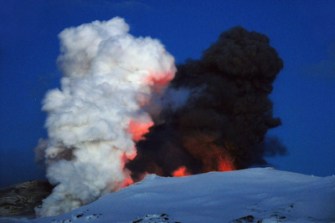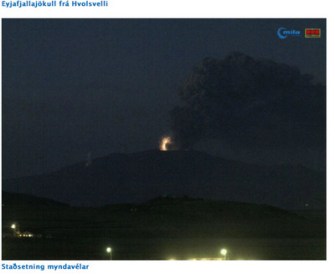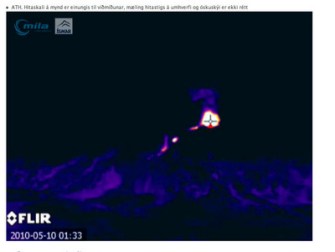Eyjafjallajökull continues to disrupt European air travel

nA shot of the summit area of Eyjafjallajökull, showing the twin steam-and-ash plumes from the lava flow and active vent. Picture taken by Dr. Joseph Licciardi (UNH).
nn
Over the weekend, the newly reinvigorated ash eruptions from Eyjafjallajökull combined with favorable winds meant that ash from the eruption closed airspace over swaths of Europe, including Ireland, Spain, Portugal, Italy, Austria and Germany. These disruptions are continuing into the new week, although most of the disruption is for transatlantic flights. However, the threat of ash is more present than ever, as Ryanair admitted to finding that two planes had ash in the engines (although at first, the airline said they were “separate technical problems unrelated to the Icelandic eruption.”) This looks like the pattern Europe may have to face over the summer: if the volcano continues on this pattern of explosive, strombolian-to-plinian style eruptions that can produce significant ash and the winds turn towards the continent, air travel will be disrupted. Some airlines are already seeing the effect of the ash on their business and this is likely to continue as people make plans for their vacations or their swanky film festivals.
nn

nStrombolian activity at Eyjafjallajökull on May 10, 2010.
nn
As for Eyjafjallajökull, the eruption is continuing on with impressive strombolian explosions (see above) in the main vent area and the continued, slow progress of the lava flow down the flank of the volcano. Dr. Joe Licciardi sent me a few more pictures where the two plumes – one mostly steam from the lava flow melting ice, one mostly ash from the active vent – can be plainly seen (see top and thermal image below). The ash production from the volcano has tapered over the weekend, but the plume is nevertheless still impressive (see at the bottom), reaching 4-6 km (14,000-20,000 feet) in height. The Icelandic Met Office says that the eruptive rate has been decreasing over the past week as the volcano has deflated, but the eruption have become spasmodic with burst of increased activity. However, none of this suggests that the eruption is anywhere close to an end.
nn

nFLIR thermal image of the Eyjafjallajökull eruption on May 10, 2010.
nn
The BBC has jumped onto the “Katla-mongering” bandwagon today as well, with a new article that offers nothing new to anyone who has been following the eruption – more or less, there is an interesting and unproven connection between the two volcano’s eruptive activity. What bugs me about this article is in the first paragraph, the writer chose to say “some reports suggest that another, much larger, volcano could stir in the near future.” (my emphasis). To me, this implies we have evidence right now that something is going on at Katla. The article, however, merely talks about what geologists are suggesting might happen. It is word choice like this (that I, too, fall prey to) that is very important when talking about volcanic hazards.
nn
nThe ash plume from Eyjafjallajökull as seen on May 8, 2010.




